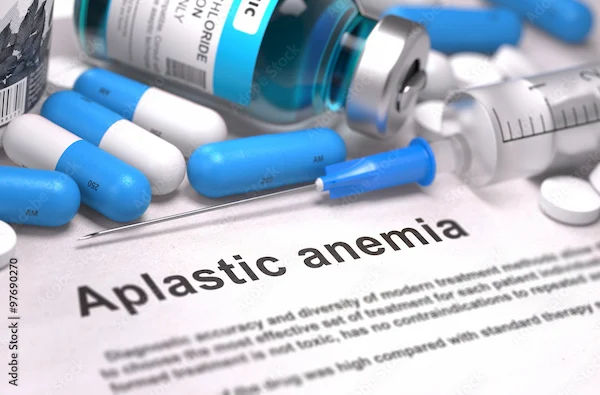Thalassaemia Symptoms And Causes
Learn about Thalassaemia, a genetic blood disorder. Explore its symptoms, causes, and how it affects the production of haemoglobin, leading to anaemia and related health issues.

Written by Dr.Sonia Bhatt
Last updated on 3rd Jul, 2025

Introduction
Thalassaemia is an inherited blood disorder that affects the body’s ability to produce normal haemoglobin. Haemoglobin is a protein found in red blood cells, responsible for transporting oxygen throughout the body, supplying the cells with the energy they need to function.
In individuals with thalassaemia, the body produces fewer healthy haemoglobin proteins, and the bone marrow produces fewer healthy red blood cells. This results in anaemia, a condition where there are not enough red blood cells to meet the body’s oxygen needs. As red blood cells play a crucial role in delivering oxygen to tissues, a lack of healthy red blood cells can deprive the body’s cells of the oxygen required to thrive. In this article, we will explore thalassaemia, its causes, symptoms, and impact.
Types of Thalassaemia
Thalassaemia is classified into trait, minor, intermedia, and major to reflect the severity of the condition. The thalassaemia trait typically causes mild or no symptoms, requiring little to no treatment, while thalassaemia major is the most severe form, usually necessitating regular treatment.
There are two main types of thalassaemia: alpha thalassaemia and beta thalassaemia, both named after defects in their respective globin chains.
1. Alpha Thalassaemia
Alpha thalassaemia occurs when there is a defect in one or more of the genes responsible for producing alpha globin chains, affecting the severity of symptoms.
Alpha thalassaemia minima: One defective gene, no symptoms.
Alpha thalassaemia minor: Two defective genes, mild symptoms.
Haemoglobin H disease: Three defective genes, moderate to severe symptoms.
Hydrops fetalis with Haemoglobin Barts: Four defective genes, often fatal or requiring lifelong blood transfusions.
2. Beta Thalassaemia
Beta thalassaemia is caused by defects in the beta-globin genes, and the severity depends on how many genes are affected and the nature of the defect.
Beta thalassaemia minor: One defective gene, mild symptoms.
Thalassaemia intermedia: Two defective genes, moderate symptoms.
Beta thalassaemia major (Cooley’s anaemia): Two defective genes, severe symptoms requiring treatment.
Causes of Thalassaemia
Haemoglobin is made up of four protein chains: two alpha globin chains and two beta globin chains. Each chain contains genetic information, or genes, inherited from your parents. These genes act as the "code" or instructions that control the formation of each chain and, by extension, your haemoglobin. If any of these genes are defective or absent, it results in thalassaemia.
Alpha globin protein chains are composed of four genes, two inherited from each parent.
Beta globin protein chains consist of two genes, one from each parent.
The type of thalassaemia you have depends on whether the genetic defect is in the alpha or beta chain. The severity of the condition is determined by the extent of the defect.
Symptoms of Thalassaemia
There are several types of thalassaemia, and the signs and symptoms vary depending on the type and severity of the condition.
Common symptoms of thalassaemia can include:
Fatigue
Weakness
Pale or yellowish skin
Facial bone deformities
Slow growth
Abdominal swelling
Dark urine
Symptoms on the type and severity of thalassaemia are as follows:
1. Asymptomatic (no symptoms)
You are unlikely to experience symptoms if you are missing one alpha gene. If you are missing two alpha genes or one beta gene, you may remain asymptomatic or experience mild anaemia symptoms, such as fatigue.
2. Mild to moderate symptoms
Beta thalassaemia intermedia may cause mild anaemia symptoms, or it may lead to more moderate symptoms, including:
Growth problems
Delayed puberty
Bone abnormalities, such as osteoporosis
An enlarged spleen (an organ in your abdomen that helps fight infection)
You may require surgery to address skeletal issues or have your spleen removed if it becomes too enlarged.
3. Severe symptoms
Missing three alpha genes (Haemoglobin H disease) usually causes anaemia symptoms from birth and leads to severe lifelong anaemia. Beta thalassaemia major (Cooley’s anaemia) often results in severe anaemia symptoms, noticeable by age 2.
Symptoms of severe anaemia may include the following, in addition to those listed for mild to moderate disease:
Poor appetite
Pale or yellowish skin (jaundice)
Dark or tea-coloured urine
Abnormal bone structure in the face
Risk Factors of Thalassaemia
Factors that increase the risk of thalassaemia include:
Family history of thalassaemia: Thalassaemia is inherited from parents to children through mutated haemoglobin genes.
Certain ancestry: Thalassaemia is more common in people of African, Mediterranean, and Southeast Asian descent.
Diagnosis of Thalassaemia
Moderate and severe thalassaemia are often diagnosed in childhood, as symptoms typically appear within the first two years of a child’s life.
Your healthcare provider may order various blood tests to diagnose thalassaemia:
Complete blood count (CBC): This test measures haemoglobin levels and the quantity (and size) of red blood cells. People with thalassaemia have fewer healthy red blood cells and less haemoglobin than usual. They may also have smaller-than-normal red blood cells.
Reticulocyte count: This test measures young red blood cells and may indicate that your bone marrow isn’t producing enough red blood cells.
Iron studies: These tests can help determine whether the cause of anaemia is an iron deficiency or thalassaemia.
Haemoglobin electrophoresis: This test is used to diagnose beta thalassaemia.
Genetic testing: This is used to diagnose alpha thalassaemia.
Treatment Options
Standard treatments for thalassaemia major include blood transfusions and iron chelation therapy.
Blood Transfusion: This involves receiving injections of red blood cells through a vein to restore normal levels of healthy red blood cells and haemoglobin. For moderate or severe thalassaemia, transfusions are typically required every four months, while for beta thalassaemia major, transfusions may be needed every two to four weeks. Occasional transfusions may also be necessary, such as during times of infection, for conditions like haemoglobin H disease or beta thalassaemia intermedia.
Iron Chelation Therapy: This treatment helps remove excess iron from your body, as frequent blood transfusions can lead to iron overload. Excess iron can damage organs. If you receive regular transfusions, you will likely be prescribed iron chelation therapy, which can be taken in pill form.
Folic Acid Supplements: These supplements assist your body in producing healthy blood cells.
Bone Marrow or Stem Cell Transplant: A bone marrow or stem cell transplant from a compatible related donor is the only known cure for thalassaemia. Compatibility means the donor shares the same types of proteins, known as human leukocyte antigens (HLA), on the surface of their cells. During the procedure, your healthcare provider will inject stem cells from the donor’s bone marrow into your bloodstream, where they will begin producing healthy blood cells within a month.
Luspatercept: This is an injection given every three weeks to help your body produce more red blood cells. It is approved in the United States for the treatment of transfusion-dependent beta thalassaemia and is also used in some other countries.
Living with Thalassaemia
Living with thalassaemia requires ongoing medical care and lifestyle adjustments to manage symptoms and prevent complications.
Regular medical check-ups are crucial, including frequent blood tests (complete blood counts and iron studies).
Annual tests may be recommended to monitor heart and liver function.
Screenings for viral infections should be done as individuals with thalassaemia are at increased risk.
Monitoring for iron overload in the liver is essential through regular testing.
Adherence to treatments, including blood transfusions and iron chelation therapy, is vital for long-term survival.
Ongoing care helps manage symptoms and prevent complications.
Prevention and Genetic Counseling
While thalassaemia cannot be prevented, genetic testing and counselling can help individuals understand their risks and make informed decisions about family planning.
Thalassaemia cannot be prevented, but genetic testing can identify whether you or your partner are carriers of the gene.
Genetic testing can guide family planning decisions and help assess the risk of passing on the condition.
Consulting a genetic counsellor is recommended for guidance on family planning and understanding potential risks.
Genetic counselling provides valuable information on testing options and available choices before conception.
Conclusion
Thalassaemia is a serious inherited blood disorder that affects the production of haemoglobin, leading to anaemia and a range of potential complications. The condition's severity varies, with treatments such as blood transfusions, iron chelation, and stem cell transplants offering management options. While thalassaemia cannot be prevented, genetic testing and counselling can help individuals understand their risks and make informed decisions for family planning. With proper care and treatment, individuals with thalassaemia can lead fulfilling lives.
Consult Top General Physicians
Consult Top General Physicians

Dr. D Bhanu Prakash
General Practitioner
10 Years • MBBS, AFIH, Advanced certificate in critical care medicine, Fellowship in critical care medicine
Hyderabad
Apollo 24|7 Clinic, Hyderabad

Dr D M Karthik
General Practitioner
4 Years • MBBS, Fellowship in Diabetes Mellitus, Advance certificate in Diabetes Mellitus, Derma Nutrition Certification
Visakhapatnam
Apollo 24|7 Clinic - Andhra Pradesh, Visakhapatnam

Dr. M L Ezhilarasan
General Practitioner
6 Years • MBBS
Visakhapatnam
Apollo 24|7 Clinic - Andhra Pradesh, Visakhapatnam

Dr. Mohammed Kamran
General Practitioner
5 Years • MBBS, FIDM
Nashik
Apollo 24|7 Clinic - Maharashtra, Nashik

Dr. Vasanthasree Nair
General Practitioner
15 Years • MBBS
Angamaly
Apollo 24|7 Clinic - Kerala, Angamaly
(425+ Patients)
